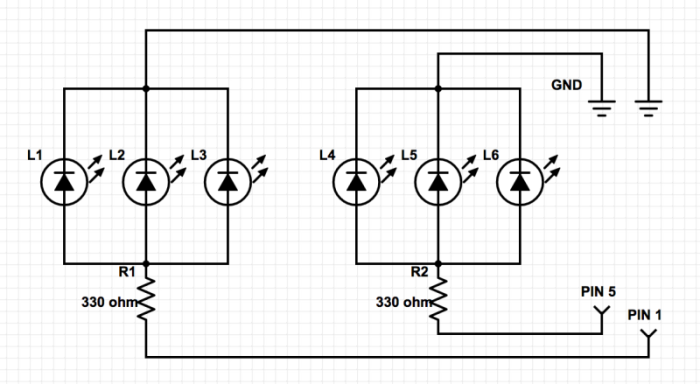Build a physical "Traffic Light"
-
- Posted: 26 Sep 2014
- Category: blog
- Tagged: examples, and consumers
-
Related Posts
- A Move to Main Branch
- Peter Moore on 13 Oct 2021
- Time Series Analysis with Jupyter Notebooks and Socrata
- rlvoyer on 07 Oct 2019
- Continual Improvement : CI / CD at Tyler Technologies, Data & Insights Division
- JoeNunnelley on 26 Sep 2019
At this year’s API Strategy & Practice Conference in Chicago, I had the pleasure of attending Matt Haines’s awesome talk about the “Internet of Things” and the Electric Imp. The Electric Imp is an awesome computing platform that combines a microprocessor and WiFi radio with an embedded OS and a Cloud platform for building and running code both locally and on their servers.
Even better, Matt handed out developer kits after his session. I took that as a personal challenge. After a quick run to a nearby RadioShack for supplies, a plan emerged.
I wanted to build something real-time, and it of course needed to be based of Chicago. I dug around a bit, and found this awesome dataset of real-time traffic congestion around the city. Using the aggregation functions of SoQL, I averaged the traffic at all of the measured intersections to create “average speed” across the whole city:
The TryIt macro has been disabled until future notice while we upgrade this site to SODA3.
First, the hardware. In about 45 minutes, using my teeth for wire strippers, I had a basic circuit on my brand new breadboard that connected my giant red and green dome LEDs to pins 1 and 5 on the Imp. They each actually contain six separate LEDs, of which I connected three in parallel through a 330-ohm resistor. A circuit diagram is below, and I apologize if you’re an electrical engineer…

And here it is in copper and silicon:

Yes, I used a conference sticker instead of solder. I was a bit short on resources.
The software is broken into two parts. The first part, the device code, runs on the microprocessor itself, and controls the pins that light up our LEDs. It has one simple job - listen for commands from the agent code, and respond by turning the pins on and off.
// Identify our hardware pins
green <- hardware.pin1;
red <- hardware.pin5
// Configure them for digital (on/off) output
green.configure(DIGITAL_OUT);
red.configure(DIGITAL_OUT);
// Functions that we'll call to control our two LEDs
function setRed(state) {
red.write(state);
}
function setGreen(state) {
green.write(state);
}
// Bind our functions to events from the Agent
agent.on("red", setRed);
agent.on("green", setGreen);Pretty simple, eh? All it does is initialize our output pins (green and red) and set up event handlers to handle the appropriate events coming from the agent. The agent then runs on the Electric Imp hosts, and thus it can interact with the rest of the web. Our agent code is more complicated, so we’ll break it up in to different parts to describe what it does.
First we start off by simply turning off both LEDs to reset our state:
// Reset them both to off
device.send("green", 0);
device.send("red", 0);Next, we define two functions. We’ll be making asynchronous HTTP requests, so we’ll define both a check_traffic() function to kick off the request, and a handle_response() function to be executed asynchronously when the HTTP request returns. Let’s first look at the check_traffic() function:
function check_traffic() {
// Call the SODA API with our query
local request = http.get("http://data.cityofchicago.org/resource/t2qc-9pjd.json?$select=avg(current_speed)&$where=current_speed%20%3E%200");
server.log("Calling API...");
request.sendasync(handle_response);
// Check again in 60 seconds
imp.wakeup(60, check_traffic);
}In this function, we:
- Define an HTTP GET request with our aggregation query
- Kick off our async HTTP request, passing
handle_responseas the handler - Schedule a wakeup in 60 seconds for the next time we want to check
When that HTTP response returns,handle_response() is called with a response object as a parameter. In the handler:
- Check to make sure everything is
200 OK - Parse our JSON response
- Send the appropriate events to the Imp device to turn the right LEDs on and off
// A function to handle our asynchronous HTTP request
function handle_response(response) {
// If something went wrong, the SODA API will return a code other than 200
if(response.statuscode != 200) {
server.log("Got status code " + response.statuscode + ": " + response.body);
return;
}
// Decode our JSON response and pull out the average speed
local traffic = http.jsondecode(response.body)[0].avg_current_speed.tofloat();
server.log("Current traffic: " + traffic);
if(traffic < 20.0) {
// Turn the red light on if the city is stuck in gridlock
device.send("green", 0);
device.send("red", 1);
} else {
// Turn on the green light if we're clear
device.send("green", 1);
device.send("red", 0);
}
}Finally, we call check_traffic() the first time to kick off our loop:
// Start our loop
check_traffic();That’s it! The Imp can operate completely disconnected from your computer, all it needs is power and a WiFi connection, so you could easily place this by your front door to make sure you’re not surprised by a traffic jam when you head out on the town.